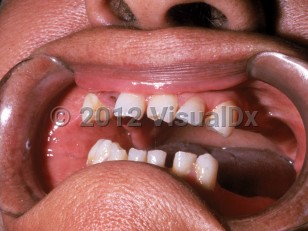Early congenital syphilis
Alerts and Notices
Important News & Links
Synopsis

Syphilis crisis in the United States: Syphilis and congenital syphilis cases have been surging nationwide, with an 80% increase in total syphilis cases between 2018 and 2022. Serologic testing is the primary means of diagnosing, staging, and managing syphilis. Testing should be done for any sexually active patient in whom syphilis is suspected or who has new, unexplained symptoms. Prompt diagnosis and treatment of syphilis can prevent systemic complications, including ocular involvement and permanent blindness.
Congenital syphilis, infection with the spirochete Treponema pallidum, is acquired by the fetus from an infected birth parent, typically in utero and less frequently at delivery through exposure to syphilitic genital lesions. Transmission can occur during any stage of pregnancy. This is termed early congenital syphilis when symptoms occur before the age of 2 years. One-half of patients are asymptomatic at birth; clinical symptoms or laboratory evidence of infection may manifest days to months later. Early congenital syphilis is characterized by a variable number of cutaneous and extracutaneous findings. Historically, infected infants were said to develop a form of rhinitis, snuffles, that is characterized by excessive blood stained nasal drainage by the infant's third week of life. Snuffles do not seem to occur with as much frequency as previously thought. Other findings include hepatomegaly, splenomegaly, lymphadenopathy, mucous patches, hemolytic anemia, thrombocytopenia, periostitis, and intrauterine growth retardation. Neurosyphilis occurs in up to 60% of symptomatic infants.
If syphilis remains latent and the infant does not exhibit symptoms until after age 2 years, the course of the disease is different (late congenital syphilis). Findings include tissue malformation at critical growth periods, incisor teeth abnormalities (called Hutchinson teeth), corneal opacities, and eighth nerve hearing impairment or deafness.
The US Centers for Disease Control and Prevention (CDC) reports that the rate of reported congenital syphilis in the United States has increased dramatically, with a tenfold increase between 2012 and 2022.
Congenital syphilis, infection with the spirochete Treponema pallidum, is acquired by the fetus from an infected birth parent, typically in utero and less frequently at delivery through exposure to syphilitic genital lesions. Transmission can occur during any stage of pregnancy. This is termed early congenital syphilis when symptoms occur before the age of 2 years. One-half of patients are asymptomatic at birth; clinical symptoms or laboratory evidence of infection may manifest days to months later. Early congenital syphilis is characterized by a variable number of cutaneous and extracutaneous findings. Historically, infected infants were said to develop a form of rhinitis, snuffles, that is characterized by excessive blood stained nasal drainage by the infant's third week of life. Snuffles do not seem to occur with as much frequency as previously thought. Other findings include hepatomegaly, splenomegaly, lymphadenopathy, mucous patches, hemolytic anemia, thrombocytopenia, periostitis, and intrauterine growth retardation. Neurosyphilis occurs in up to 60% of symptomatic infants.
If syphilis remains latent and the infant does not exhibit symptoms until after age 2 years, the course of the disease is different (late congenital syphilis). Findings include tissue malformation at critical growth periods, incisor teeth abnormalities (called Hutchinson teeth), corneal opacities, and eighth nerve hearing impairment or deafness.
The US Centers for Disease Control and Prevention (CDC) reports that the rate of reported congenital syphilis in the United States has increased dramatically, with a tenfold increase between 2012 and 2022.
Codes
ICD10CM:
A50.9 – Congenital syphilis, unspecified
SNOMEDCT:
35742006 – Congenital syphilis
A50.9 – Congenital syphilis, unspecified
SNOMEDCT:
35742006 – Congenital syphilis
Look For
Subscription Required
Diagnostic Pearls
Subscription Required
Differential Diagnosis & Pitfalls

To perform a comparison, select diagnoses from the classic differential
Subscription Required
Best Tests
Subscription Required
Management Pearls
Subscription Required
Therapy
Subscription Required
References
Subscription Required
Last Reviewed:10/13/2021
Last Updated:04/03/2024
Last Updated:04/03/2024
Early congenital syphilis

